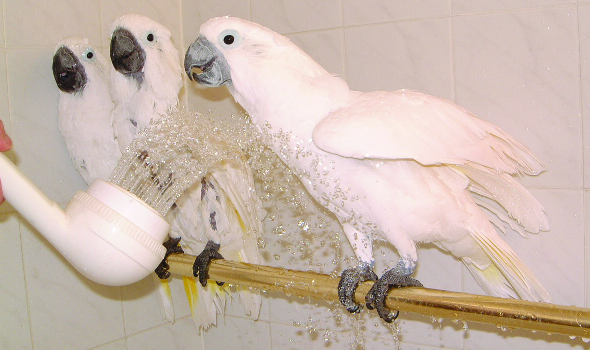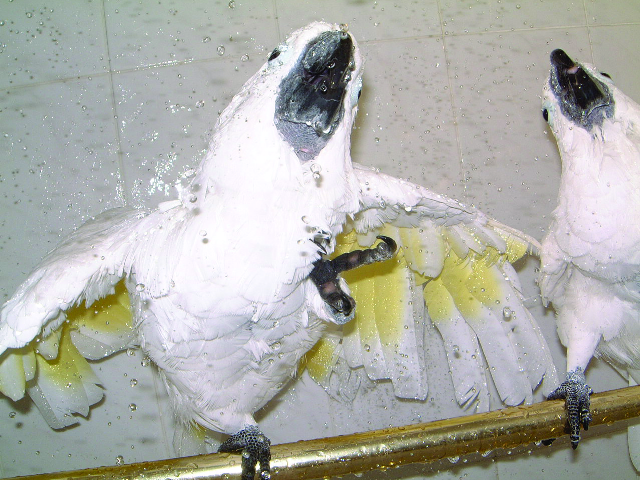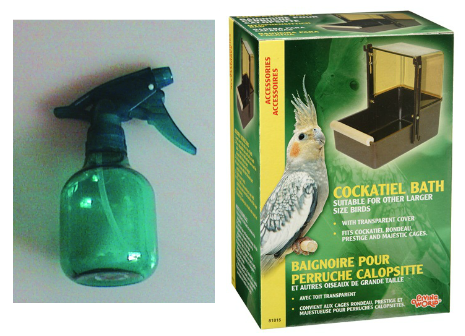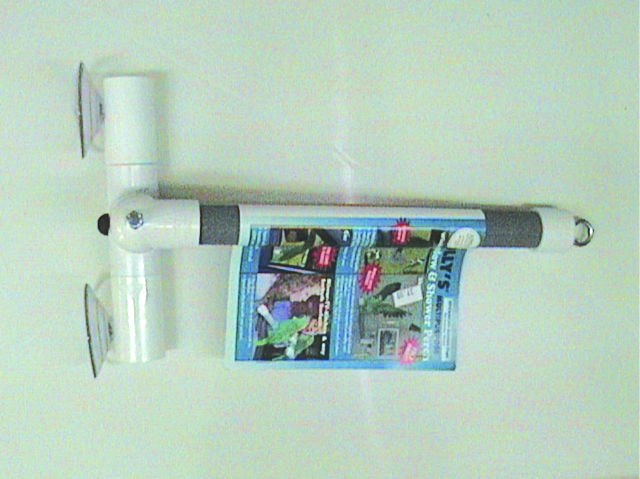
Bathing & Showering an Essential in Basic Bird Care
The Rain Dance
 Being a bird owner is a big responsibility. Our avian companions depend on us for every aspect of their care and well-being – ranging from the physical to the psychological. Over the years I’ve learned many tricks and tips for providing basic bird care to our feathered friends.
Being a bird owner is a big responsibility. Our avian companions depend on us for every aspect of their care and well-being – ranging from the physical to the psychological. Over the years I’ve learned many tricks and tips for providing basic bird care to our feathered friends.
Whether it’s to clean feathers, encourage grooming, provide relief for dry skin, prevent or discourage feather-damaging behavior, or simply for the sheer enjoyment of it – baths (or showers) are an essential component of basic bird care.
Baths (or showers) can play a first-aid role as well. If you suspect a pin feather (growing feather with blood in the shaft); wish to provide relief for a wound or injury; suspect pododermatitis (bumble foot), or simply to evaluate the alertness of a suspiciously inactive bird – then bathing (or showering) can be used as a way to evaluate the level of seriousness before you consult with your avian veterinarian.
Caution must be taken to always provide a draft-free environment and have a warm heating source or lamp (100 watts is usually sufficient) in the room for when the misting, bathing; or shower time is over. If the weather conditions are warm enough, you can also bathe your birds outside with the garden hose. However, you should let the water run for a few minutes to help get rid of any bacteria that might have built up inside the hose. The same is true when misting your birds with a spray bottle. Bacteria can build up inside the bottle, so don’t keep the same water in the bottle for days on end. Between each usage, the spray bottle should be emptied, rinsed and dried.

Bath Time
Various techniques can be used when bathing birds indoors. These include using an infant-sized bath tub with an inch or two of water in it, bathing or showering the bird directly in or over the sink with the faucet running, adapting perches for use in the shower, or simply waterproof the walls adjacent to your pet’s perch and mist the bird with a spray bottle. If your bird prefers to bathe on their own, there are many types of bird- baths available on the market which can be fitted onto the cage.
Amongst the popular parrot species, most prefer showers and misters to bathing. Soft bills, Lories, Quakers and others might prefer using a birdbath, while African Grays enjoy bathing and showering equally. Some owners share quality time with their pets by sharing their showers with them, with the birds either perched onto the shower curtain or using a shower perch designed for this purpose. In the end, it comes down to the bird’s individual preference.

Showering
Even parrots that don’t seem to like water for bathing or those that engage in feather damaging behaviors, such as plucking and chewing, tend to volunteer more readily if the water temperature of the mist, spray or shower is warm. The water temperature can be the same as when you shower, provided there are no temperature fluctuations, to avoid radical heat and cold exposures.
All my companion Cockatoos prefer showering. To minimize the effort and save some time, I have adopted a method that suits everyone at once.
 Here is my favorite Shower Time Technique
Here is my favorite Shower Time Technique
- Put your parrot on a solid and properly affixed shower pole. Remember to place friends side by side and rivals at the opposing extremities, and those who love water besides those who are unsure and hesitant.
- Pull in the shower curtain. Start the shower and adjust to a warm temperature. Cockatoos love to get drenched, soaked to bare skin when the temperature permits.
- When everyone is wet, and you are still comfortably sitting on the toilet seat with its cover down, in front of your parrots, vocalize to them, repeat sounds such as: “BRRRR!” And encourage them to “Ruffle those feathers!”.
- Spread your arms and shake them like tree branches fidgeting in the wind and see what will happen! The rain dance for your feathered companions.
- Magical moments can be witnessed during these quality bathing times.
Text and photos by: Celine Wandowska


